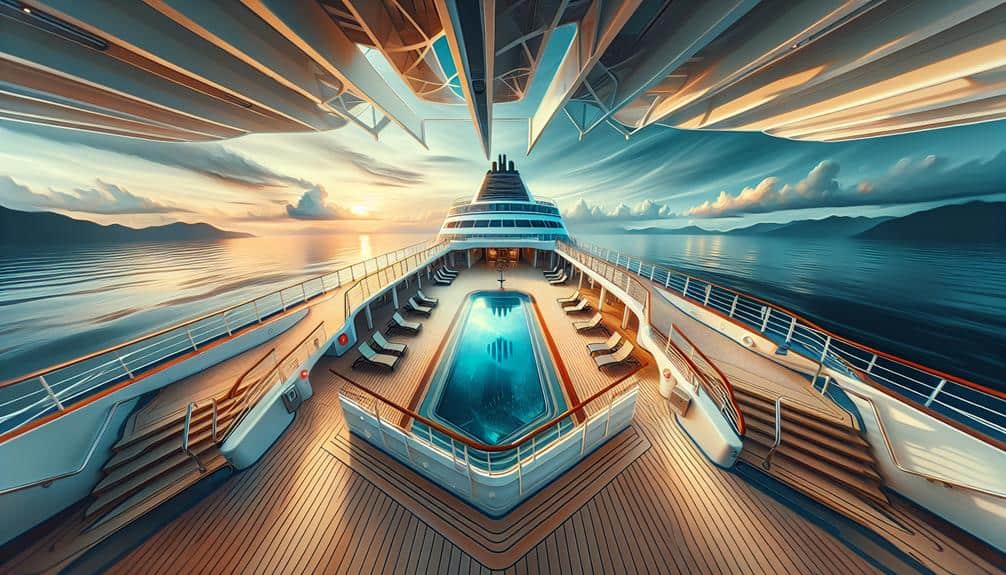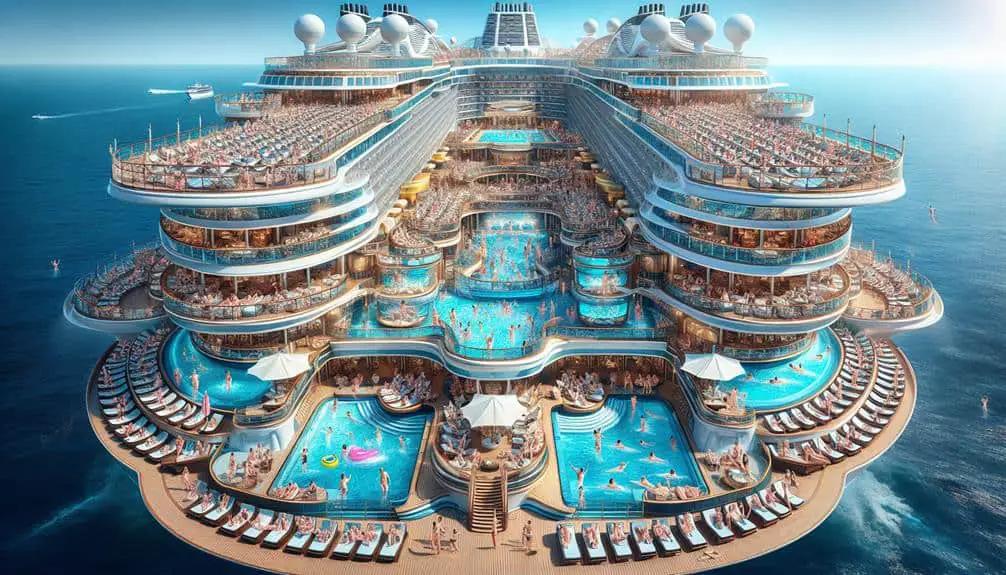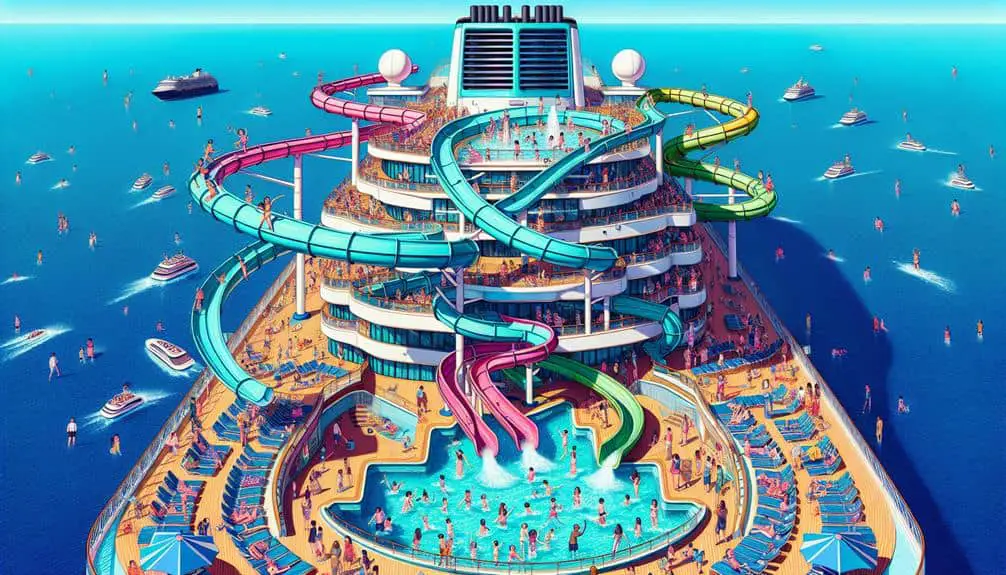To reduce sea sickness on large cruise ships, opt for a cabin in the ship's middle section for less movement. Engage in distracting activities to prevent nausea. Design features like fin stabilizers and gyroscopic stabilizers improve stability. Weight distribution impacts center of gravity; proper balance reduces rolling and pitching. Larger ships with wider beams offer more resistance to tipping. Understanding ship size, passenger behavior, and pivotal advancements play significant roles in mitigating motion discomfort. Making informed choices onboard can greatly enhance your comfort at sea. Mastering the science behind ship dynamics is key to a smoother sailing experience.
Key Points
- Utilize advanced stabilization systems like fin stabilizers and gyroscopic stabilizers.
- Opt for ships with wider beams for increased resistance to tipping.
- Design interior layout to distribute weight evenly for better stability.
- Choose cabins in the middle of the ship to reduce motion sickness.
- Engage in distracting activities or focus on the horizon to prevent nausea.
Impact of Ship Size on Comfort
When considering the impact of ship size on comfort, larger cruise ships tend to provide more stability in rough seas compared to smaller vessels. This increased stability can be attributed to specific design features and interior layout choices that larger ships incorporate.
Design features play a vital role in enhancing stability. Larger ships are equipped with advanced stabilization systems such as fin stabilizers or gyroscopic stabilizers. These systems work by counteracting the ship's movements caused by waves, reducing the rolling and pitching motions that can lead to seasickness. Additionally, the increased size of the ship allows for a wider beam, providing more resistance to tipping.
Moreover, the interior layout of larger cruise ships is designed to distribute weight more evenly throughout the vessel. This balanced distribution helps to minimize the impact of rough seas on the ship's stability. Public areas, cabins, and amenities are strategically positioned to make sure that the ship maintains its equilibrium even in challenging sea conditions. By optimizing design features and interior layout, larger cruise ships offer passengers a more comfortable and stable cruising experience.
Influence of Passenger Capacity on Stability
The passenger capacity of a cruise ship directly influences its stability in varying sea conditions, impacting the overall comfort of passengers onboard. When considering the influence of passenger capacity on stability, several key factors come into play:
- Passenger Behavior: The movement of passengers within the ship can affect its balance. Higher passenger capacity can lead to more significant shifts in weight distribution, potentially impacting stability.
- Crew Response: With increased passenger capacity, crew members must be vigilant in monitoring and adjusting to any changes in the ship's stability. Quick and essential responses are vital to maintaining comfort and safety.
- Design Modifications: Ships with larger passenger capacities may require specific design modifications to enhance stability. These adjustments can include changes to the hull shape, ballast systems, and overall weight distribution.
- Technological Advancements: Advancements in technology, such as the integration of stabilizing systems, can help mitigate the impact of higher passenger capacities on a ship's stability. These systems work to counteract the forces that may destabilize the vessel, providing a smoother experience for passengers.
Connection Between Vessel Dimensions and Nausea
Passenger susceptibility to nausea on large cruise ships shows a direct correlation with specific vessel dimensions, particularly in relation to motion-induced discomfort. The location of cabins on a ship can have a notable impact on the likelihood of passengers experiencing motion sickness. Cabins located in the middle of the ship, closer to the waterline, tend to experience less movement and rocking compared to cabins situated at the bow or stern. This is due to the physics of how ships move through the water, with the middle being the most stable area.
When it comes to onboard activities, engaging in distracting or stabilizing activities can help prevent nausea. Participating in activities that keep you occupied and focused can reduce the feeling of motion sickness. Additionally, staying on deck and focusing on the horizon can help your body adjust to the motion of the ship, reducing the chances of feeling nauseous. By being mindful of cabin location and engaging in activities that promote stability, passengers can better manage motion-induced discomfort on large cruise ships.
Relationship Between Ship Length and Rocking
Considering the impact of ship length on rocking motion, an essential analysis reveals the direct relationship between the two factors. Ship design plays a vital role in how vessels interact with wave patterns, ultimately affecting the rocking experienced by passengers.
Here is a breakdown of the relationship between ship length and rocking:
- Wave Interaction: Longer ships have a larger surface area that comes into contact with waves, leading to increased rocking motion.
- Period of Waves: The length of the ship can influence how it aligns with the wave patterns, affecting the magnitude of the rocking sensation.
- Stability: Longer ships tend to have better stability in calm seas due to their increased mass and resistance to wave forces.
- Maneuverability: However, longer ships may experience more pronounced rocking during sharp turns or in rough seas due to their extended structure.
Understanding the intricate relationship between ship length and rocking is essential in optimizing ship design to minimize motion sensitivity and enhance passenger comfort.
Role of Ship Weight in Motion Sensitivity
Analyzing ship weight's impact on motion sensitivity reveals essential insights into optimizing cruise ship design for enhanced passenger comfort and reduced sea sickness. Weight distribution plays a vital role in the dynamics of a cruise ship at sea. The distribution of weight across a vessel affects its center of gravity, which in turn influences its stability in response to waves and winds. Ships with improper weight distribution may experience more pronounced rolling and pitching motions, leading to increased motion sensitivity among passengers and a higher risk of motion sickness.
In the domain of motion sickness prevention, ensuring proper weight distribution is paramount. By strategically placing heavier components, such as engines and fuel tanks, lower in the ship's hull, designers can lower the ship's center of gravity, enhancing its stability and reducing excessive motion. Additionally, optimizing weight distribution helps minimize the ship's tendency to list or heel, further enhancing passenger comfort. Understanding the intricate relationship between ship weight, weight distribution, and motion sensitivity is fundamental to crafting cruise ships that offer a smoother and more pleasant sailing experience for all onboard.
Frequently Asked Questions
How Do the Amenities and Activities Offered on Large Cruise Ships Impact Passengers' Susceptibility to Sea Sickness?
The amenities and activities on large cruise ships can impact your susceptibility to sea sickness. Entertainment options, dining choices, fitness facilities, and spa services can distract you from feeling unwell, contributing to a more enjoyable journey.
Are There Specific Areas or Decks on a Cruise Ship That Are Less Prone to Motion Sickness Than Others?
When selecting your cabin location on a cruise ship, consider higher decks and midship positions as they typically experience less motion, reducing the likelihood of seasickness. Deck positioning plays an essential role in minimizing discomfort at sea.
Can the Design and Layout of a Cruise Ship Affect the Likelihood of Passengers Experiencing Sea Sickness?
You might think cruise ship design doesn't sway sea sickness, but cabin layouts, ventilation, meal timing, and seating arrangements all play roles. Scientifically examining these factors can reveal insights for minimizing discomfort at sea.
Are There Any Technological Advancements or Innovations Being Implemented on Large Cruise Ships to Reduce the Effects of Sea Sickness?
Virtual reality and motion tracking technologies are revolutionizing the cruise industry. Passengers benefit from immersive experiences and precise monitoring of movements, ultimately enhancing comfort and reducing the effects of sea sickness on large cruise ships.
How Do Environmental Factors, Such as Weather Conditions and Ocean Currents, Play a Role in Passengers' Comfort and Stability on a Cruise Ship?
When aboard a cruise ship, your comfort and stability are intricately linked to environmental factors. The strategic placement of cabins, efficient ventilation, stabilizers, and appropriate lighting work harmoniously to guarantee you experience a smooth and pleasant journey.




